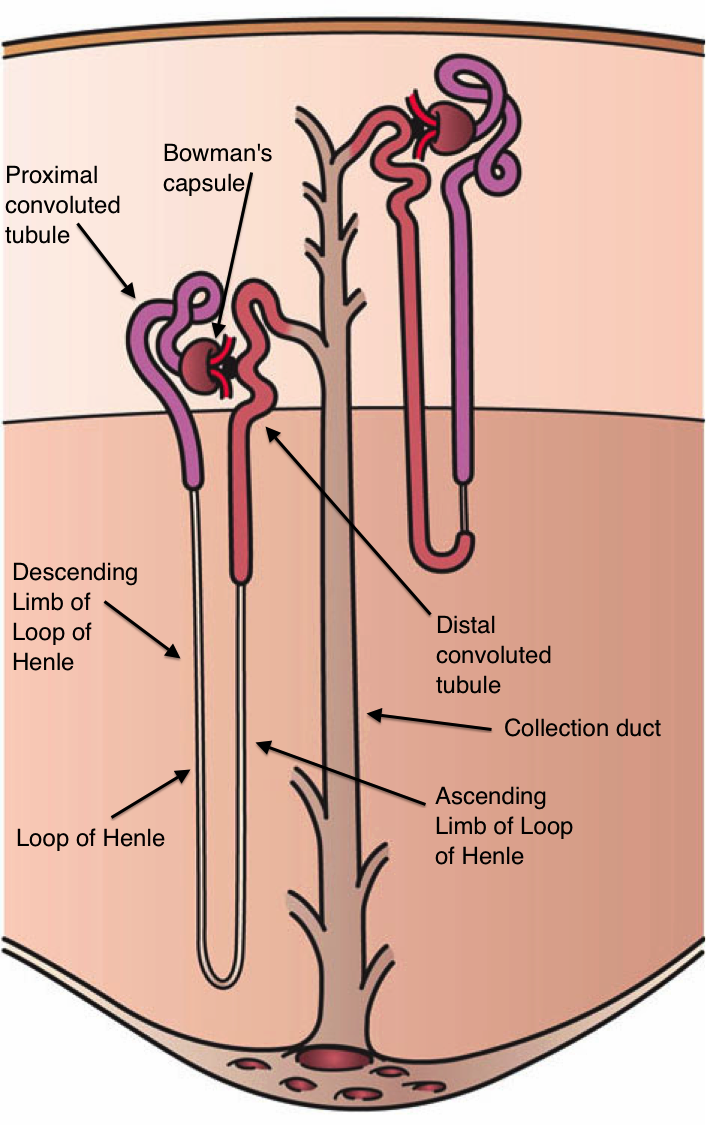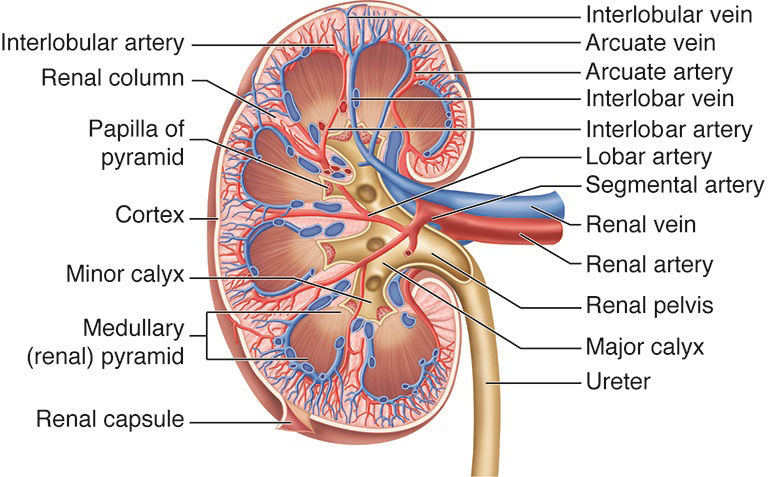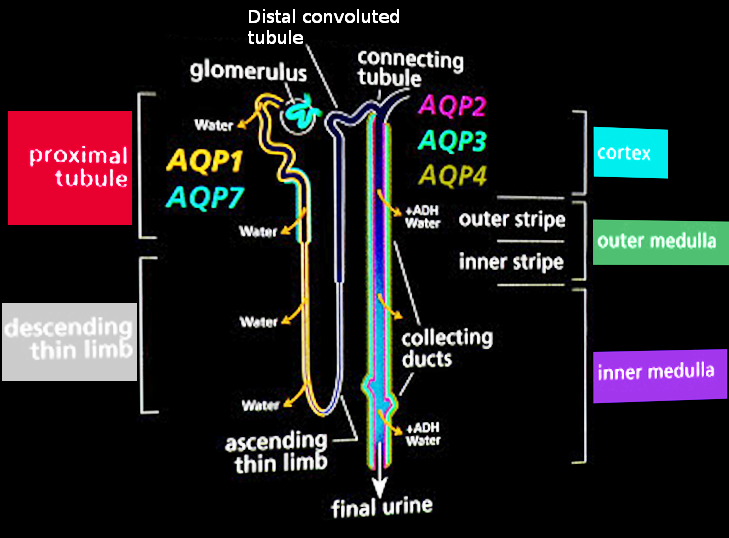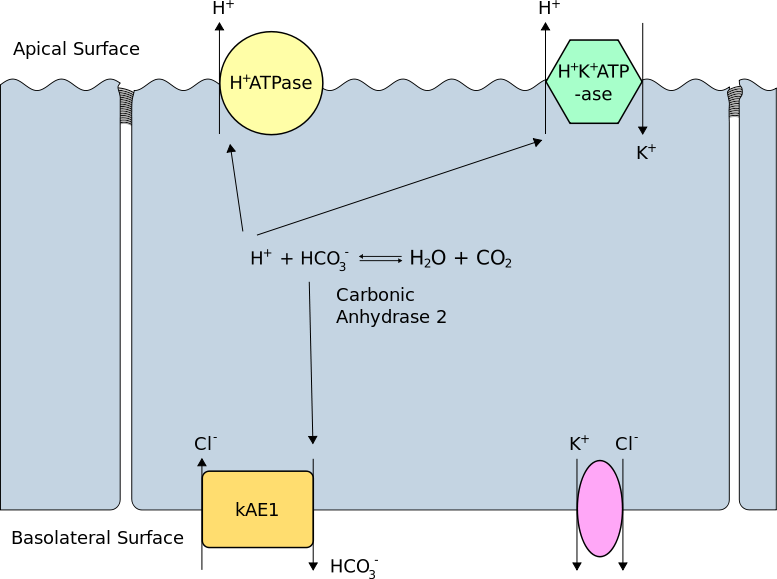[1]
Staruschenko A. Regulation of transport in the connecting tubule and cortical collecting duct. Comprehensive Physiology. 2012 Apr:2(2):1541-84
[PubMed PMID: 23227301]
[2]
Pearce D, Soundararajan R, Trimpert C, Kashlan OB, Deen PM, Kohan DE. Collecting duct principal cell transport processes and their regulation. Clinical journal of the American Society of Nephrology : CJASN. 2015 Jan 7:10(1):135-46. doi: 10.2215/CJN.05760513. Epub 2014 May 29
[PubMed PMID: 24875192]
[3]
Roy A, Al-bataineh MM, Pastor-Soler NM. Collecting duct intercalated cell function and regulation. Clinical journal of the American Society of Nephrology : CJASN. 2015 Feb 6:10(2):305-24. doi: 10.2215/CJN.08880914. Epub 2015 Jan 28
[PubMed PMID: 25632105]
[4]
Weiner ID, Mitch WE, Sands JM. Urea and Ammonia Metabolism and the Control of Renal Nitrogen Excretion. Clinical journal of the American Society of Nephrology : CJASN. 2015 Aug 7:10(8):1444-58. doi: 10.2215/CJN.10311013. Epub 2014 Jul 30
[PubMed PMID: 25078422]
[6]
Krause M, Rak-Raszewska A, Pietilä I, Quaggin SE, Vainio S. Signaling during Kidney Development. Cells. 2015 Apr 10:4(2):112-32. doi: 10.3390/cells4020112. Epub 2015 Apr 10
[PubMed PMID: 25867084]
[7]
Dressler GR. The cellular basis of kidney development. Annual review of cell and developmental biology. 2006:22():509-29
[PubMed PMID: 16822174]
[8]
Apelt K, Bijkerk R, Lebrin F, Rabelink TJ. Imaging the Renal Microcirculation in Cell Therapy. Cells. 2021 May 2:10(5):. doi: 10.3390/cells10051087. Epub 2021 May 2
[PubMed PMID: 34063200]
[9]
Jamkar AA, Khan B, Joshi DS. Anatomical study of renal and accessory renal arteries. Saudi journal of kidney diseases and transplantation : an official publication of the Saudi Center for Organ Transplantation, Saudi Arabia. 2017 Mar-Apr:28(2):292-297. doi: 10.4103/1319-2442.202760. Epub
[PubMed PMID: 28352010]
[11]
Russell PS, Hong J, Windsor JA, Itkin M, Phillips ARJ. Renal Lymphatics: Anatomy, Physiology, and Clinical Implications. Frontiers in physiology. 2019:10():251. doi: 10.3389/fphys.2019.00251. Epub 2019 Mar 14
[PubMed PMID: 30923503]
[15]
Torres PA, Helmstetter JA, Kaye AM, Kaye AD. Rhabdomyolysis: pathogenesis, diagnosis, and treatment. Ochsner journal. 2015 Spring:15(1):58-69
[PubMed PMID: 25829882]
[16]
Chitalia V. Muscles Protect the Kidneys. Science translational medicine. 2014 Dec 24:6(268):. pii: 268ec219. doi: 10.1126/scitranslmed.aaa3464. Epub
[PubMed PMID: 29977461]
[17]
Cui Y, Tong A, Jiang J, Wang F, Li C. Liddle syndrome: clinical and genetic profiles. Journal of clinical hypertension (Greenwich, Conn.). 2017 May:19(5):524-529. doi: 10.1111/jch.12949. Epub 2016 Nov 29
[PubMed PMID: 27896928]
[18]
Tinawi M. Pathophysiology, Evaluation, and Management of Metabolic Alkalosis. Cureus. 2021 Jan 21:13(1):e12841. doi: 10.7759/cureus.12841. Epub 2021 Jan 21
[PubMed PMID: 33628696]
[19]
Alhuzaim ON, Almohareb OM, Sherbeeni SM. Carbonic Anhydrase II Deficiency in a Saudi Woman. Clinical medicine insights. Case reports. 2015:8():7-10. doi: 10.4137/CCRep.S16897. Epub 2015 Feb 3
[PubMed PMID: 25674028]
Level 3 (low-level) evidence
[20]
Ciszewski S, Jakimów A, Smolska-Ciszewska B. Collecting (Bellini) duct carcinoma: A clinical study of a rare tumour and review of the literature. Canadian Urological Association journal = Journal de l'Association des urologues du Canada. 2015 Sep-Oct:9(9-10):E589-93. doi: 10.5489/cuaj.2932. Epub 2015 Sep 9
[PubMed PMID: 26425219]
[21]
Pal SK, Choueiri TK, Wang K, Khaira D, Karam JA, Van Allen E, Palma NA, Stein MN, Johnson A, Squillace R, Elvin JA, Chmielecki J, Yelensky R, Yakirevich E, Lipson D, Lin DI, Miller VA, Stephens PJ, Ali SM, Ross JS. Characterization of Clinical Cases of Collecting Duct Carcinoma of the Kidney Assessed by Comprehensive Genomic Profiling. European urology. 2016 Sep:70(3):516-21. doi: 10.1016/j.eururo.2015.06.019. Epub 2015 Jul 3
[PubMed PMID: 26149668]
Level 3 (low-level) evidence
[22]
Sui W, Matulay JT, Robins DJ, James MB, Onyeji IC, RoyChoudhury A, Wenske S, DeCastro GJ. Collecting duct carcinoma of the kidney: Disease characteristics and treatment outcomes from the National Cancer Database. Urologic oncology. 2017 Sep:35(9):540.e13-540.e18. doi: 10.1016/j.urolonc.2017.04.010. Epub 2017 May 8
[PubMed PMID: 28495554]
[23]
Kavanagh C, Uy NS. Nephrogenic Diabetes Insipidus. Pediatric clinics of North America. 2019 Feb:66(1):227-234. doi: 10.1016/j.pcl.2018.09.006. Epub
[PubMed PMID: 30454745]
[25]
Zieg J. Pathophysiology of Hyponatremia in Children. Frontiers in pediatrics. 2017:5():213. doi: 10.3389/fped.2017.00213. Epub 2017 Oct 16
[PubMed PMID: 29085814]
[26]
Urso C, Brucculeri S, Caimi G. Employment of vasopressin receptor antagonists in management of hyponatraemia and volume overload in some clinical conditions. Journal of clinical pharmacy and therapeutics. 2015 Aug:40(4):376-85. doi: 10.1111/jcpt.12279. Epub 2015 Apr 29
[PubMed PMID: 25924179]
[27]
Palmer BF, Kelepouris E, Clegg DJ. Renal Tubular Acidosis and Management Strategies: A Narrative Review. Advances in therapy. 2021 Feb:38(2):949-968. doi: 10.1007/s12325-020-01587-5. Epub 2020 Dec 26
[PubMed PMID: 33367987]
Level 3 (low-level) evidence
[28]
Al-Beltagi M, Saeed NK, Bediwy AS, Elbeltagi R, Hasan S, Hamza MB. Renal calcification in children with renal tubular acidosis: What a paediatrician should know. World journal of clinical pediatrics. 2023 Dec 9:12(5):295-309. doi: 10.5409/wjcp.v12.i5.295. Epub 2023 Dec 9
[PubMed PMID: 38178934]
[29]
Emmett M. Metabolic Alkalosis: A Brief Pathophysiologic Review. Clinical journal of the American Society of Nephrology : CJASN. 2020 Dec 7:15(12):1848-1856. doi: 10.2215/CJN.16041219. Epub 2020 Jun 25
[PubMed PMID: 32586924]
[30]
Vaidya A, Mulatero P, Baudrand R, Adler GK. The Expanding Spectrum of Primary Aldosteronism: Implications for Diagnosis, Pathogenesis, and Treatment. Endocrine reviews. 2018 Dec 1:39(6):1057-1088. doi: 10.1210/er.2018-00139. Epub
[PubMed PMID: 30124805]
[32]
Barbot M, Ceccato F, Scaroni C. The Pathophysiology and Treatment of Hypertension in Patients With Cushing's Syndrome. Frontiers in endocrinology. 2019:10():321. doi: 10.3389/fendo.2019.00321. Epub 2019 May 21
[PubMed PMID: 31164868]
[34]
Epstein M, Calhoun DA. Aldosterone blockers (mineralocorticoid receptor antagonism) and potassium-sparing diuretics. Journal of clinical hypertension (Greenwich, Conn.). 2011 Sep:13(9):644-8. doi: 10.1111/j.1751-7176.2011.00511.x. Epub 2011 Aug 9
[PubMed PMID: 21896143]
[35]
Shah SS, Zhang J, Gwini SM, Young MJ, Fuller PJ, Yang J. Efficacy and safety of mineralocorticoid receptor antagonists for the treatment of low-renin hypertension: a systematic review and meta-analysis. Journal of human hypertension. 2024 Jan 11:():. doi: 10.1038/s41371-023-00891-1. Epub 2024 Jan 11
[PubMed PMID: 38200100]
Level 1 (high-level) evidence
[36]
Werth M, Schmidt-Ott KM, Leete T, Qiu A, Hinze C, Viltard M, Paragas N, Shawber CJ, Yu W, Lee P, Chen X, Sarkar A, Mu W, Rittenberg A, Lin CS, Kitajewski J, Al-Awqati Q, Barasch J. Transcription factor TFCP2L1 patterns cells in the mouse kidney collecting ducts. eLife. 2017 Jun 3:6():. pii: e24265. doi: 10.7554/eLife.24265. Epub 2017 Jun 3
[PubMed PMID: 28577314]
Level 2 (mid-level) evidence
[37]
Hajarnis S, Yheskel M, Williams D, Brefort T, Glaudemans B, Debaix H, Baum M, Devuyst O, Patel V. Suppression of microRNA Activity in Kidney Collecting Ducts Induces Partial Loss of Epithelial Phenotype and Renal Fibrosis. Journal of the American Society of Nephrology : JASN. 2018 Feb:29(2):518-531. doi: 10.1681/ASN.2017030334. Epub 2017 Oct 11
[PubMed PMID: 29021386]
[38]
Tingskov SJ, Choi HJ, Holst MR, Hu S, Li C, Wang W, Frøkiær J, Nejsum LN, Kwon TH, Nørregaard R. Vasopressin-Independent Regulation of Aquaporin-2 by Tamoxifen in Kidney Collecting Ducts. Frontiers in physiology. 2019:10():948. doi: 10.3389/fphys.2019.00948. Epub 2019 Aug 9
[PubMed PMID: 31447686]



